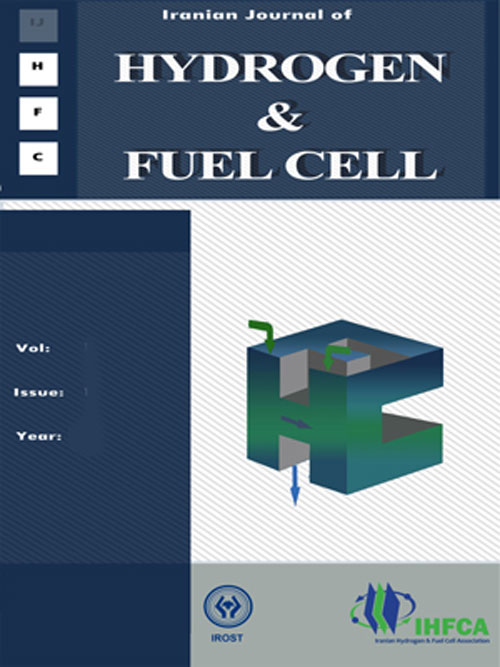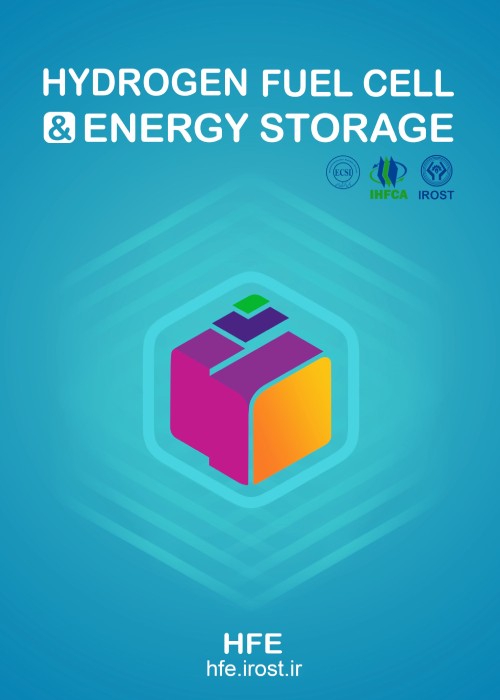فهرست مطالب

Journal of Hydrogen, Fuel Cell and Energy Storage
Volume:2 Issue: 1, Winter 2015
- تاریخ انتشار: 1394/03/12
- تعداد عناوین: 6
-
-
Pages 1-6In this research the simulation of an air independent Proton Exchange Membrane Fuel Cell (PEMFC) propulsion system was taken into consideration. The system consists of several parts including PEM fuel cell stack, metal hydride and liquid oxygen (LOX) tanks, and also pre-heaters of oxygen and hydrogen gases along with other heat exchangers, to ensure proper operation of system. The heat recovery system was used in order to cool the PEM fuel cell stack and use its wasted heat effectively in other sections to increase the overall efficiency of the propulsion system. In this study, an appropriate design for heat recovery system with consideration of operation conditions and overall performance was done. In addition, the operation of the whole of energy management system by utilizing the wasted heat from the PEMFC has been simulated, and the effects of operating parameters such as different PEMFC power, its operating temperature and cooling water mass flow rate were investigated and discussed.Keywords: Energy Management, Thermal Efficiency, Metal Hydride, LOX Tank
-
Pages 7-12Reduced graphene oxide film was synthesized on a glassy carbon electrode by electro reduction of graphene oxide powders in aqueous solution. Then platinum nano particles were deposited on reduced graphene oxide film that was deposited on the glassy carbon electrode via electro reduction of platinum salt. The Physical morphology of the platinum on reduced graphene oxide film was evaluated by scanning electron microscopy (SEM) and energy dispersive X-ray analysis (EDX). The results showed that, Platinum particles were deposited on reduced graphene oxide film. The performance of Pt on reduced graphene oxide for oxygen reduction reaction was considered with linear sweep voltammetry and electrochemical impedance spectroscopy of catalyst in an acidic solution via three electrode configuration cell. The results showed the proper performance of this green synthesized catalyst for oxygen reduction reaction. so this method for catalyst fabrication is a good candidate for the cathode of proton exchange membrane fuel cells.Keywords: Platinum, Oxygen reduction reaction, Proton Exchange Membrane Fuel Cell (PEMFC), reduced graphene oxide (RGO)
-
Pages 13-25In present research work, homogeneous anion exchange membranes based on polysulfone (QAPSFs) were prepared via chloromethylation, amination and alkalization. In amination step, trimethylamine and N,N,N',N'-tetramethyl-1,6-hexanediamine were used as amination and crosslinking agents, respectively. The chloromethylated polysulfone was characterized by 1HNMR spectroscopy and chloromethylation degree was calculated using peak area integration. Ion transport properties such as ionic conductivity, ion exchange capacity, activation energy for hydroxide ion transport were measured for the prepared anion exchange membranes. Furthermore, water content associated properties such water uptake and hydrated number were determined for these membranes. According to the obtained results, the membrane with crosslinking agent (QAPSF-2) shows ion transport properties nearly similar to the membrane without crosslinker (QAPSF-1). Although, QAPSF-2 has more improved water content associated properties and reasonable dimensional stability in contrast to QAPSF-1. Finally, According to the ionic transport measurements and water content characterizations, the prepared QAPSF membranes can be denoted as good candidates for solid alkaline fuel cell application.Keywords: Solid Alkaline Fuel Cell, Anion Exchange Membrane, Polysulfone, Amination Agents
-
Pages 27-33We report a Pd-Co (3:1)/graphene oxide (Pd3Co /GO) catalyst through a one-step strategy. GO is synthesized from graphite electrodes using ionic liquid-assisted electrochemical exfoliation. Controllable GO-supported Pd3Co electrocatalystis then was reduced by ethylene glycol as a stabilizing agent to prepare highly dispersed PdCo nanoparticles on carbon graphene oxide to be used as oxygen reduction reaction in passive direct methanol fuel cell (DEFC) catalysts. The performance of these electrodes in the ORR was measured with cyclic voltammetry (CV), linear sweep voltammetry (LSV), electrochemical impedance spectroscopy (EIS), chronoamperometry (CA), inductive coupled plasma (ICP), X-ray diffraction (XRD) and scanning electron microscopy coupled to energy dispersive X-ray (SEM–EDX). Since the Pd3Co/GO alloy electrocatalysts are inactive for the adsorption and oxidation of methanol, it can act as a methanol-tolerant ORR catalyst in a direct methanol fuel cell (DMFC). A membrane-electrode assembly (MEA) has been prepared by employing of the Pd3Co/GO as a cathode for passive direct methanol fuel cell and characterized by polarization curves and impedance diagrams. A better performance was obtained for the cell using Pd3Co/RGO (3.56 mW cm–2) compared to Pd/RGO (1.75 mW cm–2) and Pt/C-Electrochem (1.9 mW cm–2) as cathode in the DMFC.Keywords: one, step synthesis, reduced graphene oxide, Pd, Co nanoparticles, ORR, passive DMFC
-
Pages 35-46A numerical model is developed to simulate the transport phenomena in the flow channel between parallel plates with porous and non-porous (or impermeable) walls. The continuity and momentum equations were solved first, assuming the wall Reynolds number in the range of with the suction or injection of air at a speed equal to the uniform inlet velocity. The results show that at constant inlet and wall Reynolds number, the friction factor on porous wall with suction is bigger than that with injection, but the axial non-dimensional pressure drop with injection is larger than the pressure drop in fully developed flow between impermeable plates and also larger than the pressure drop with suction. This is because of the net increase of the mean velocity of flow along the channel when injection is imposed. In the presence of suction, the pressure drop is controlled by suction rate, and approaches to a constant value as the inertia and viscous forces are counterbalanced in the flow. The energy equation is solved independently assuming constant suction rate of air in the porous wall using different thermal boundary conditions. The results show that the Nusselt number distribution along the channel depends on the thermal boundary conditions imposed on porous and non-porous walls. The thermal characteristics also depend on whether suction or injection occurs through the porous waKeywords: Modeling, Developing flow, Heat, mass transfer, Channel
-
Pages 47-58In this study, a sodalite nanozeolite was synthesized and characterized by X-ray diffraction (XRD) and scanning electronic microscopy (SEM). Following the morphology evolution of the sodalite nanozeolite in the SEM images illustrates the formation of the spherical particle with a size between 60 and 80 nm. Then, carbon paste electrode (CPE) was modified by sodalite nanozeolite and Ni2+ ions. The electrocatalytic performance of the fabricated electrode (Ni-SOD/CPE) towards glucose oxidation were evaluated by cyclic voltammetry and Chronoamperometry and it was used as anode for the electrocatalytic oxidation of glucose in 0.1 M of NaOH solution. Also, the electron transfer coefficient, the diffusion coefficient and the mean value of catalytic rate constant for glucose and redox sites of electrode were found to be 0.86, 3.13×10−5 cm2 s−1 and 5.34×106 cm3 mol−1 s−1, respectively. Good catalytic activity, high sensitivity, good choice and the stability and easy preparation enables the modified electrodes for the glucose electrooxidation. The obtained data confirmed that sodalite nanozeolite at the surface of CPE improves the catalytic efficiency of the dispersed nickel ions toward glucose oxidation. The Alkaline direct glucose fuel cells operated at ambient temperature with Ni-SOD/CPE anode created maximum power density of 4.1 mW cm-2 and cathode feed 4 mL min-1 of 0.1 M glucose and oxygen at 1 bar.Keywords: Sodalite nanozeolite, Electrooxidation, Glucose, Modified carbon paste electrode, Alkaline direct glucose fuel cells


